Measure Descriptions for Low Tidal Volume Ventilation: Slide Presentation
AHRQ Safety Program for Mechanically Ventilated Patients
Slide 1: AHRQ Safety Program for Mechanically Ventilated Patients
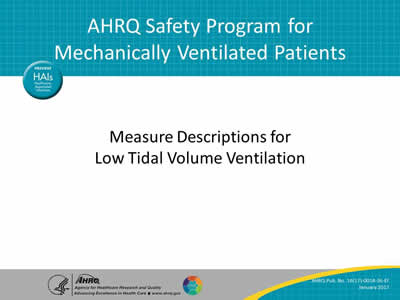
Measure Descriptions for Low Tidal Volume Ventilation
Slide 2: Learning Objectives
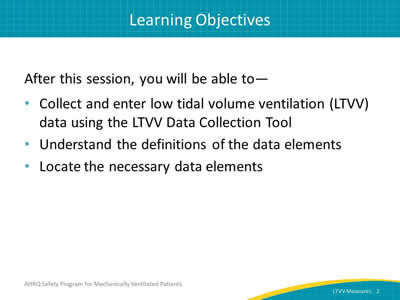
After this session, you will be able to—
- Collect and enter low tidal volume ventilation (LTVV) data using the LTVV Data Collection Tool.
- Understand the definitions of the data elements.
- Locate the necessary data elements.
Slide 3: LTVV: Key Interventions
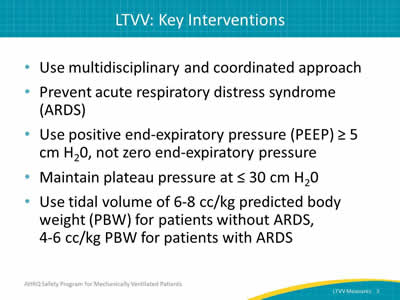
- Use multidisciplinary and coordinated approach.
- Prevent acute respiratory distress syndrome (ARDS).
- Use positive end-expiratory pressure (PEEP) ≥ 5 cm H20, not zero end-expiratory pressure.
- Maintain plateau pressure at ≤ 30 cm H20.
- Use tidal volume of 6-8 cc/kg predicted body weight (PBW) for patients without ARDS, 4-6 cc/kg PBW for patients with ARDS.
Slide 4: Data Collection
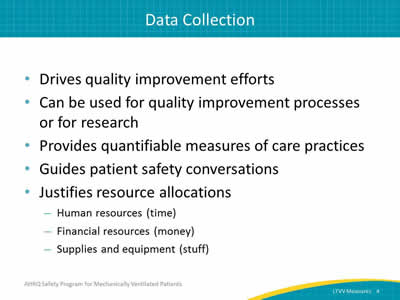
- Drives quality improvement efforts.
- Can be used for quality improvement processes or for research.
- Provides quantifiable measures of care practices.
- Guides patient safety conversations.
- Justifies resource allocations:
- Human resources (time).
- Financial resources (money).
- Supplies and equipment (stuff).
Slide 5: LTVV Data Collection Tool
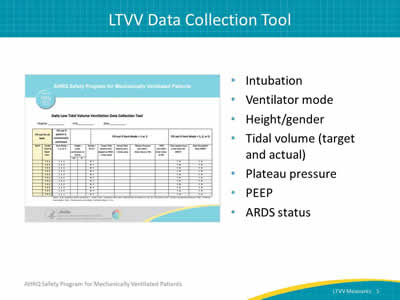
- Intubation.
- Ventilator mode.
- Height/gender.
- Tidal volume (target and actual).
- Plateau pressure.
- PEEP.
- ARDS status.
Image; The data collection tool.
Slide 6: Data Collection: Intubation and Ventilator Mode
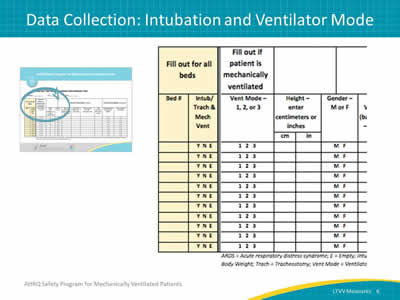
Image: Close up view of first columns of LTVV Data collection tool. Includes bed number, intubation/trach/mech vent status (Y/N/E), place to circle if Vent Mode category (1,2, or 3), and place to record height and gender.
Slide 7: Let’s Begin…
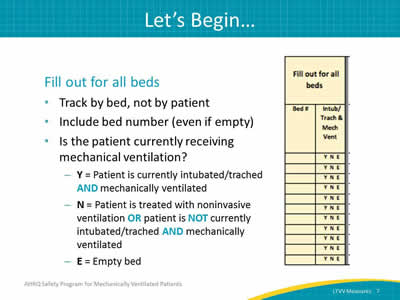
Fill out for all beds:
- Track by bed, not by patient.
- Include bed number (even if empty).
- Is the patient currently receiving mechanical ventilation?
- Y = Patient is currently intubated/trached AND mechanically ventilated.
- N = Patient is treated with noninvasive ventilation OR patient is NOT currently intubated/trached AND mechanically ventilated.
- E = Empty bed.
Image: Close up view of first columns of LTVV Data collection tool. Includes bed number, intubation/trach/mech vent status (Y/N/E).
Slide 8: Ventilator Modes—Volume-Cycled Modes
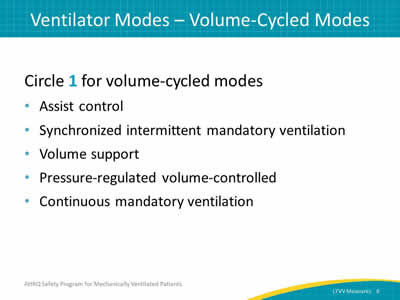
Circle 1 for volume-cycled modes:
- Assist control.
- Synchronized intermittent mandatory ventilation.
- Volume support.
- Pressure regulated volume controlled.
- Continuous mandatory ventilation.
Slide 9: Ventilator Modes—Pressure-Cycled Modes
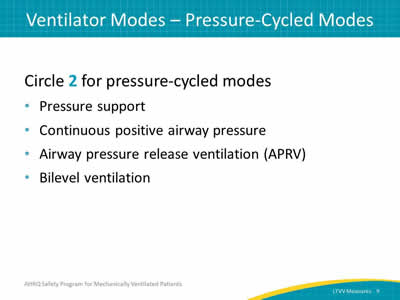
Circle 2 for pressure-cycled modes:
- Pressure support.
- Continuous positive airway pressure.
- Airway pressure release ventilation (APRV).
- Bilevel ventilation.
Slide 10: Ventilator Modes—Other Modes
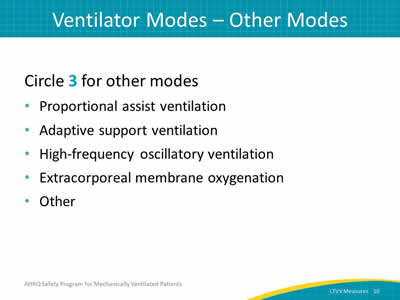
Circle 3 for other modes:
- Proportional assist ventilation.
- Adaptive support ventilation.
- High-frequency oscillatory ventilation.
- Extracorporeal membrane oxygenation.
- Other.
Slide 11: For Vent Modes 1 and 2 Only
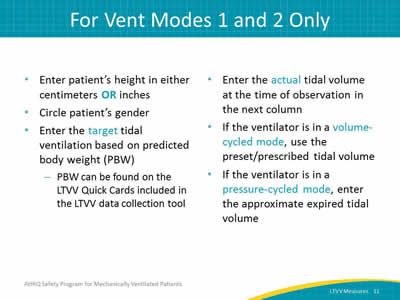
- Enter patient’s height in either centimeters OR inches.
- Circle patient’s gender.
- Enter the target tidal ventilation based on predicted body weight (PBW):
- PBW can be found on the LTVV Quick Cards included in the LTVV data collection tool.
- Enter the actual tidal volume at the time of observation in the next column.
- If the ventilator is in a volume-cycled mode, use the preset/prescribed tidal volume.
- If the ventilator is in a pressure-cycled mode, enter the approximate expired tidal volume.
Slide 12: For Vent Modes 1 and 2 Only
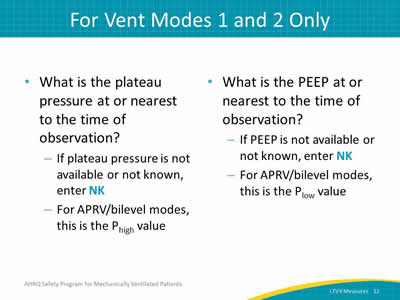
- What is the plateau pressure at or nearest to the time of observation?
- If plateau pressure is not available or not known, enter NK.
- For APRV/bilevel modes, this is the Phigh value.
- What is the PEEP at or nearest to the time of observation?
- If PEEP is not available or not known, enter NK.
- For APRV/bilevel modes, this is the Plow value.
Slide 13: Data Collection: ARDS
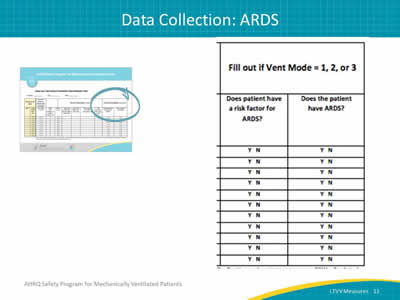
Images: Close up view of first columns of LTVV Data collection tool. Includes two questions to complete for all patients with Vent Modes 1, 2, or 3: Does patient have a risk factor for ARDS? and Does the patient have ARDS?
Slide 14: For ALL Vent Modes (1, 2, or 3)
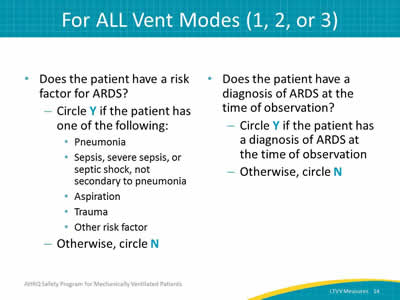
- Does the patient have a risk factor for ARDS?
- Circle Y if the patient has one of the following:
- Pneumonia.
- Sepsis, severe sepsis, or septic shock, not secondary to pneumonia.
- Aspiration.
- Trauma.
- Other risk factor.
- Otherwise, circle N.
- Circle Y if the patient has one of the following:
- Does the patient have a diagnosis of ARDS at the time of observation?
- Circle Y if the patient has a diagnosis of ARDS at the time of observation.
- Otherwise, circle N.
Slide 15: Data Measures Guide
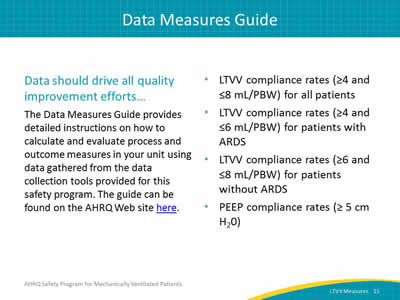
Data should drive all quality improvement efforts…
The Data Measures Guide provides detailed instructions on how to calculate and evaluate process and outcome measures in your unit using data gathered from the data collection tools provided for this safety program. The guide can be found on the AHRQ Web site here (Word File, 553 KB).
- LTVV compliance rates (≥4 and ≤8 mL/PBW) for all patients.
- LTVV compliance rates (≥4 and ≤6 mL/PBW) for patients with ARDS.
- LTVV compliance rates (≥6 and ≤8 mL/PBW) for patients without ARDS.
- PEEP compliance rates (≥5 cm H20).
Slide 16: Questions?

Image: Picture of hanging colored tags with question marks on them.



